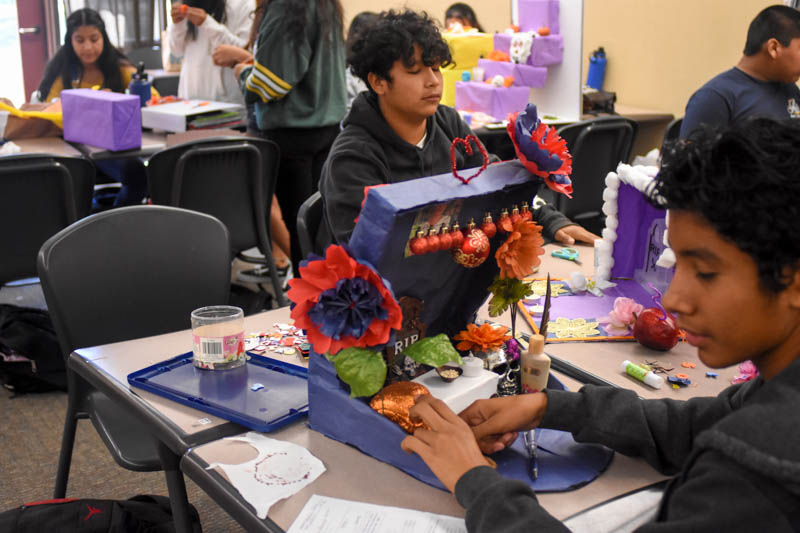Altar Project Allows Students to Dig Deep Into Family History
Students in Lorena Sanchez’s Spanish for Spanish Speakers I class work on constructing their altars. The project serves to immerse the students in the Day of the Dead culture and also to connect with loved ones who have passed away through research of their lives.
November 11, 2019
Students in select Spanish classes have been constructing altars dedicated to loved ones or celebrities that have passed away to commemorate the Day of the Dead, a holiday celebrated primarily in Mexico from October 31st to November 2nd.
On the night of November 1st, cemeteries in Mexico come to life, as people visit the graves of their loved ones and celebrate their lives by constructing altars and putting forward the loved one’s favorite food or items symbolizing their favorite activities as offerings.
The project is designed to replicate this event with the construction of altars and presentation of offerings based off of the subject’s interests, but the teachers also hope that students are able to make a more personal connection to their loved one’s life story and get to know them better through their research.
“A lot of our kids also learn from loved ones that maybe they didn’t meet and they meet them through this altar because they need to ask their parents for help,” said Spanish teacher, Lorena Perez Sanchez, who does the project in her Spanish for Spanish Speakers I class.
The SSS I students create the altar about a family member or friend that has passed away, and the SSS II students create the altar about a favorite celebrity. Spanish teacher Natalie Chavez also does the project with her Spanish III students about a celebrity, although it is more limited considering they have less knowledge and experience with the language.
Chavez has a unique structure for her Spanish III class in which she focuses on the culture of one Spanish-speaking country per month in addition to the standard curriculum, and runs the project alongside the month for Mexico. “I personally believe that culture is very important and I like adding that piece to take a break from grammar and vocab,” said Chavez.
The project is very popular among the students because of the connection that they are able to form not only with the culture, but with loved ones or role models that have passed away.
“For the most part, our students love it and the parents love it too because we’re teaching them something that maybe their family hasn’t celebrated for a long time for whatever reason,” said Sanchez, “We have a huge buy-in and a lot of our students freshman year can’t wait to do the celebrity one.”
Keanna Boessler, junior, created an altar for her aunt last year, and won the competition for best altar. “We put flowers on it with a bunch of things she liked to do,” said Boessler, “I really liked it because it gave us a chance to do something that involved our culture.”
The projects are on display in the library and students are encouraged to go and view them and support the creators. “We want to get as much exposure to these altars as possible just because the students get really into it and a lot of them, their family member passed on recently so it’s something that they feel connected to,” said Sanchez.
Students will vote on the best decorated altars and the winners will receive extra credit and a certificate.


